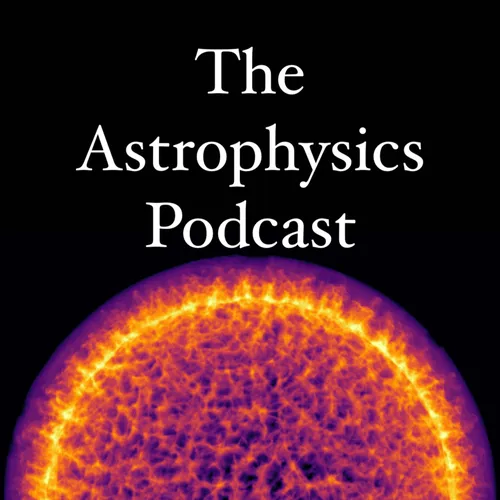
The Astrophysics Podcast
Once a month, Purdue University's Professor Paul Duffell discusses astronomy and astrophysics with experts from around the world. Duffell and guests discuss supernovae, galaxies, planets, black holes, and the nature of space and time.
Supported by the National Science Foundation under grant AAG-2206299.
Music by Brittain Ashford.
Produced in beautiful Lafayette, Indiana by Paul Duffell.
- Update frequency
- every 30 days
- Average duration
- 60 minutes
- Episodes
- 21
- Years Active
- 2024 - 2025

Dr. Wen-Fai Fong -- The Neutron Star Mash
What kinds of things do neutron stars do? They can smash into each other, producing bright flashes of radiation and strong ripples in spacetime that can be detected across the universe! Or, a neutr…

Dr. Daniel D'Orazio -- The Black Hole Shuffle
Just how big can black holes get? Well, they can get super-massive! That is, millions to billions of times as massive as the sun. How do we know this? We've detected these supermassive black hole…

Dr. Abigail Polin -- Astrophysics Q & A
In this week's episode, Dr. Abigail Polin joins us to answer your questions from the internet, on a variety of topics tangentially related to astrophysics! Questions range from the basic and fundame…

Dr. Andrea Derdzinski -- How do we see black holes?
A black hole is so dense, its gravitational field prevents anything from escaping, including light. You would think that would make them the "blackest" things in the universe; how in the world do we…

Dr. Jared Goldberg -- Does Betelgeuse have a Betelbuddy?
Up in Orion's shoulder sits Betelgeuse, a supergiant star near the end of its life. The surface of Betelgeuse has been roiling and pulsing for centuries, as long as humans have recorded its modulated…

Dr. Yvette Cendes -- Black Holes on the Radio
What happens when a black hole eats up a star? Apparently a lot of things happen, and if you wait around awhile and look in the radio, even more things happen! Dr. Yvette Cendes tells us what it's …

Dr. Maxim Lyutikov -- How do you make a Fast Radio Burst?
Some things happen out in the universe that are too powerful to make in a lab. Other phenomena are so coherent and well-ordered, we can't figure out how they can be made without a lab! Fast radio b…

Dr. Lindsey Kwok -- The Forensic Science of Supernovae
How do we know so much about supernovae, when all we see is this little point of light getting brighter and then dimmer over time? Given this minimal data, we can often say what type of star exploded…

Dr. Paul Duffell -- The Universe on a Computer (with host Dr. Abigail Polin)
How big a computer do you need to simulate a supernova? Or a planet being formed? Or a black hole swallowing gas? Many astrophysicists spend their time developing computational models to simulate …

Dr. Brenna Mockler -- When Black Holes Get Hungry
What do black holes like to eat? Sometimes a steady diet of interstellar gas just isn't enough and a black hole needs to snack on a whole star. No judgment, we all get that way sometimes. But it c…

Dr. Dan Milisavljevic -- Into the Time Domain
Our universe isn't just a static, unchanging backdrop. It is constantly changing in time and we now have the technology to image it over and over again to explore all those changes. This is called …

Dr. Katelyn Breivik -- How Binary Stars Evolve
What would our solar system be like if we had two suns? Actually, this situation could be more common than you might think, as most stars are in binary systems. If a star is in a binary pair, how d…

Dr. Kyoungsoo Lee -- Our Galactic Neighborhood
What's the biggest thing in the universe, besides the universe itself? Well, stars live in galaxies, and galaxies live in large collections called galaxy clusters. Astronomers can study these titan…

Dr. Jason Wang -- Taking a Photo of an Exoplanet
For centuries, all that we have known about planets was confined to our own solar system, and its occasionally-changing number of planets (eight as of now). But in the past several decades, astronom…

Dr. Rosalba Perna -- The Neighborhood of a Supermassive Black Hole
Planets orbit stars, and moons orbit planets, so what orbits a supermassive black hole? Possibly a whole lot of stuff, including a gaseous disk, thousands of stars and more "normal size" black holes…

Dr. Soham Mandal -- What Happens to Supernovae After they Explode?
When a star explodes, it's not finished having an impact on its surroundings. For the next thousand years or so, we can still see it as a supernova remnant, when the explosion has expanded to large …

Dr. Yuan Li -- Our Turbulent Universe
What is turbulence? You've probably experienced it before on a plane (or perhaps on a river) but you might not know precisely what it is. But turbulence is all around us, and in particular we find …

Dr. Ashley Villar -- Big Data in Astrophysics
Astronomers deal with huge datasets, and they are about to get even bigger with the construction of the Vera Rubin Observatory. When you can detect a million supernovae per year, how do we make sens…

Dr. Frank Timmes -- Pulsing White Dwarfs, Neutrinos, and the Infrastructure of Research
What are neutrinos and where do they come from? How do we know what's going on in the interior of a star when we can only see the surface? How does a paper get accepted into a scientific journal? We …

Dr. Erica Nelson -- Watching the First Galaxies Form
How did the galaxies form and how can we learn about them? Professor Erica Nelson of the University of Colorado, Boulder tells us how we use the James Webb Space Telescope (JWST) to look back in tim…